Ask any 5 people what makes the tropical island of Sri Lanka such an appealing and alluring country…. and you are likely to get 5 different answers.
This is because Sri Lanka has SO much diversity to offer.
For us, Sri Lanka’s wild elephants population has, from the very start, been a core part of our Sri Lankan experience.
We were enroute from Thailand to Southern India, when we first visited Sri Lanka for three weeks. We had discovered that Sri Lanka has a large wild elephant population and that was reason enough to change our plans and incorporate a stop.
On this first trip Peta fell in love with the baby elephant, Namal, at the Elephant Transit Center in Udawalawe.
This little guy had a tremendous impact on us, and we resolved to do what we could to help him get a better prosthetic leg, as what we saw was disheartening, to say the least.
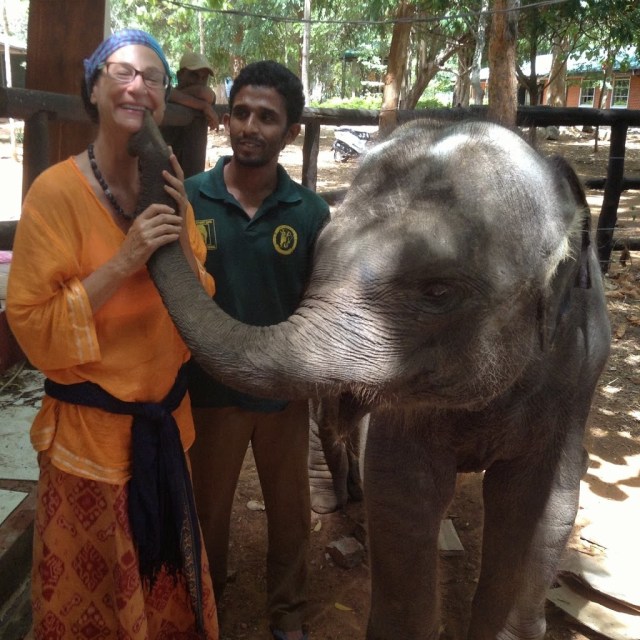
Definitely love at first kiss!
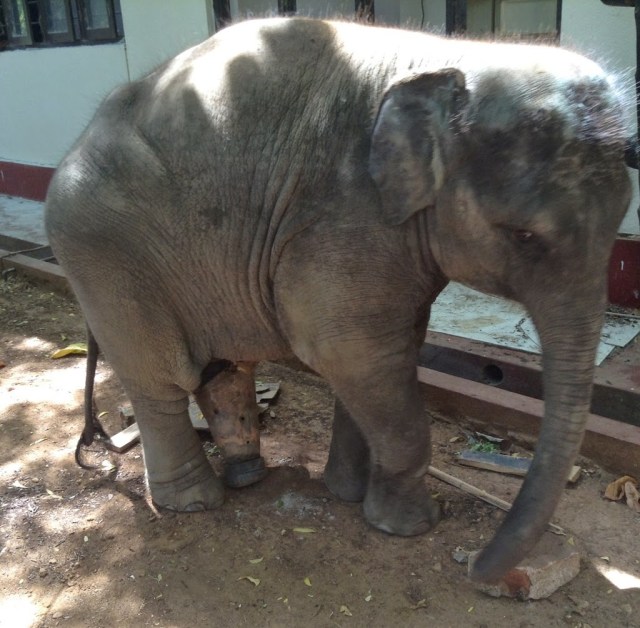
You can see the “makeshift” prosthetic leg on Namal‘s left back leg.
To read about our first meeting with baby elephant Namal, and the story of his need for a prosthetic leg, read the blog post below…..
http://www.greenglobaltrek.org/2014/10/climate-change-udawalawe-national-park-and-its-elephants.html
Then, in trying to come up with a solution for Namal, Ben went into a “deep dive” of all prosthetic technologies available, learning the pros and cons of 3D printing for both human and elephant prosthetics. This in due course eventually led us to a group of Sri Lankan professionals who are specialized veterinarians, prosthetic makers and elephant experts and animal activists.
Long story short, on our second trip to Sri Lanka, we met with this group and were fortunate to be there the very day baby Namal, then 4, and no longer the little guy, but rather a more robust version of his smaller self, got his first new prosthetic leg.
Peta’s task on the day of the fitting at the Elephant Transit Home, was to distract Namal with treats of watermelon, while a team of handlers lifted him in order to attach his new prosthetic leg.
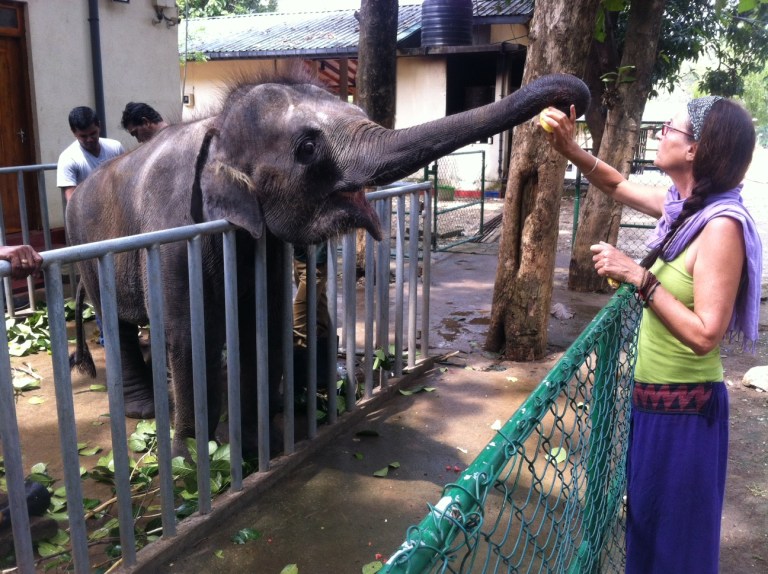
Namal ate these watermelons like a kid eats popcorn….and Peta of course, loved her job of cracking watermelons open at rapid pace to keep Namal happy.
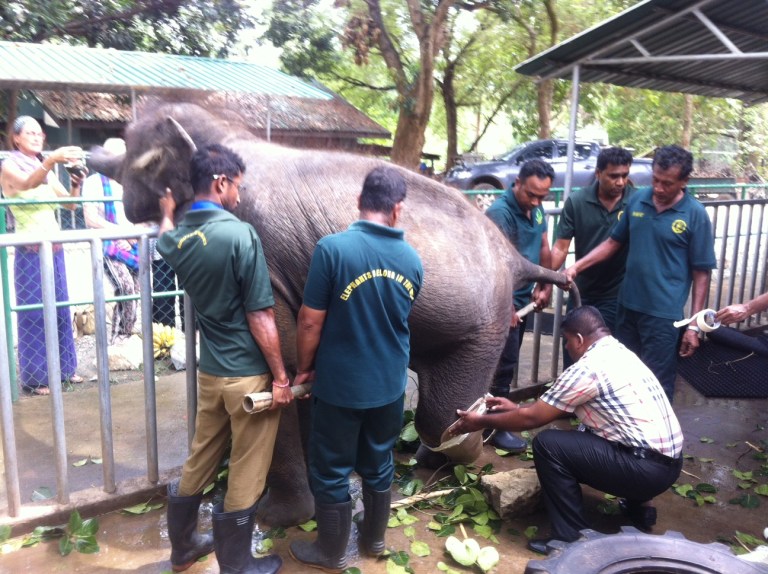
It took a whole team of men to lift Namal’s hind leg in order to attach the prosthetic device.
For the blog story we wrote which describes in more detail how Namal got his new prosthetic leg, check out the post below…..
http://www.greenglobaltrek.org/2016/04/i-made-a-promise-to-an-elephant-in-sri-lanka.html
And today, March 20th 2017, as we open the local newspaper, there is a story about the elephant orphanage at Uduwalawe. The article has a paragraph about Namal as the first elephant in the world to receive a prosthetic hind leg. (The veterinarian specialist who heads the team, had worked in Thailand where he successfully made a prosthetic leg for an elephant there who needed a front leg.)
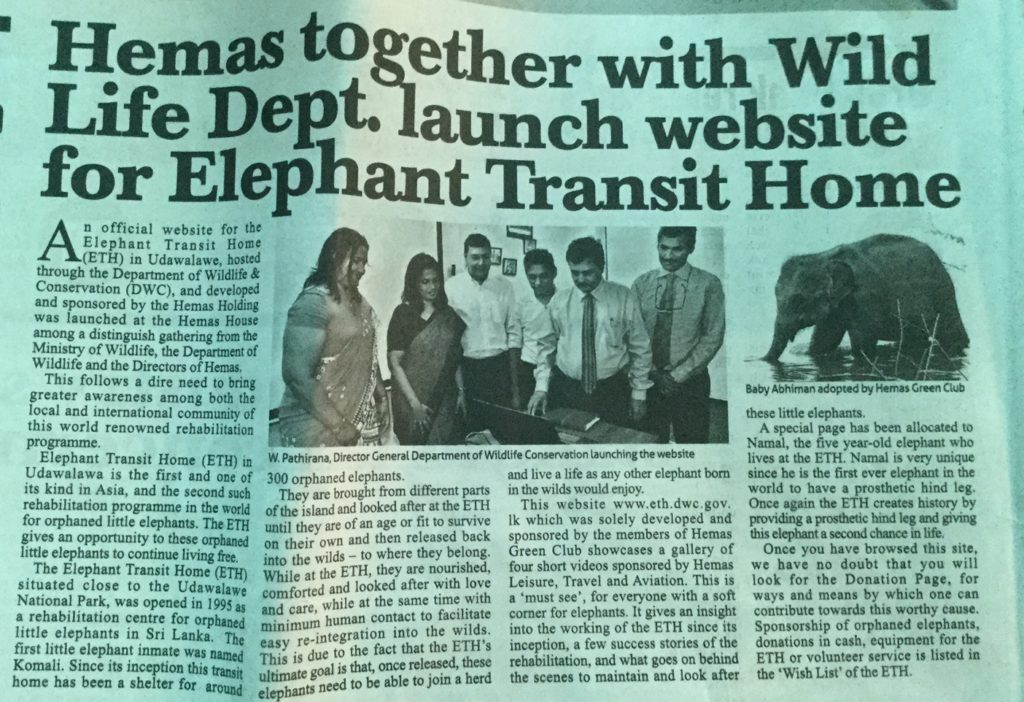
We are overjoyed to see that the Elephant Transit Home, (a phenomenal institution that has already cared for over 300 baby elephants) has been recognized in the media for it’s good work.
And our friend Namal has his very own page on the Ministry of Wildlife department’s website. The great part about this, is that the page will serve to hopefully attract more funding to support Namal’s need for new prosthetics twice a year as he keeps growing bigger and heavier.
Buoyed by the news that the Elephant Transit Home in Udawalawe has gotten the much needed visibility for its good work, from the Ministry of Wildlife, we start to consider a broader set of elephant centric issues that we need to better understand in order to perhaps contribute in some way.
There is much to do with regard to the well-being of elephants in Sri Lanka.
Of course, we are very aware of how complex achieving impact is, and we do not wish to seem flippant about what we think we can do to assist. So let’s say we are establishing the trajectory of where and how we would like to have impact…
Here are two of the major, complex issues and problems facing wild elephants in Sri Lanka today.
Drought
There is a recurring problem, every year, when droughts are severe, in Sri Lanka. The wild elephant population suffers directly from the lack of water, which translates into a lack of food. Elephants eat a tremendous amount of food and droughts impact their food source directly. So, not surprisingly, when there is a lack of rain, elephants start to reach out beyond their normal habitat in search of food and water. This leads to all sorts of human/elephant conflicts as elephants raid villages that were built by humans directly on the path of migrating elephants.
Perhaps technology can be deployed, such as desalination plants, that can take advantage of nearby sea water to provide potable water for elephant (and human) populations during droughts…
Elephant / Train collisions
There is a recurring problem in Sri Lanka, as there is in India, of trains hitting elephants, on a fairly regular basis. This is a heart-wrenching problem.
India has started to address this problem by deploying infra red cameras on its trains to act as early warning systems for the train conductor to slow down and avoid hitting elephants crossing train tracks. Perhaps such systems can be deployed in Sri Lanka as well.
~~~~~
So all this to say, we are very happy to share the news that Namal now has received an improved and functional prosthetic leg.
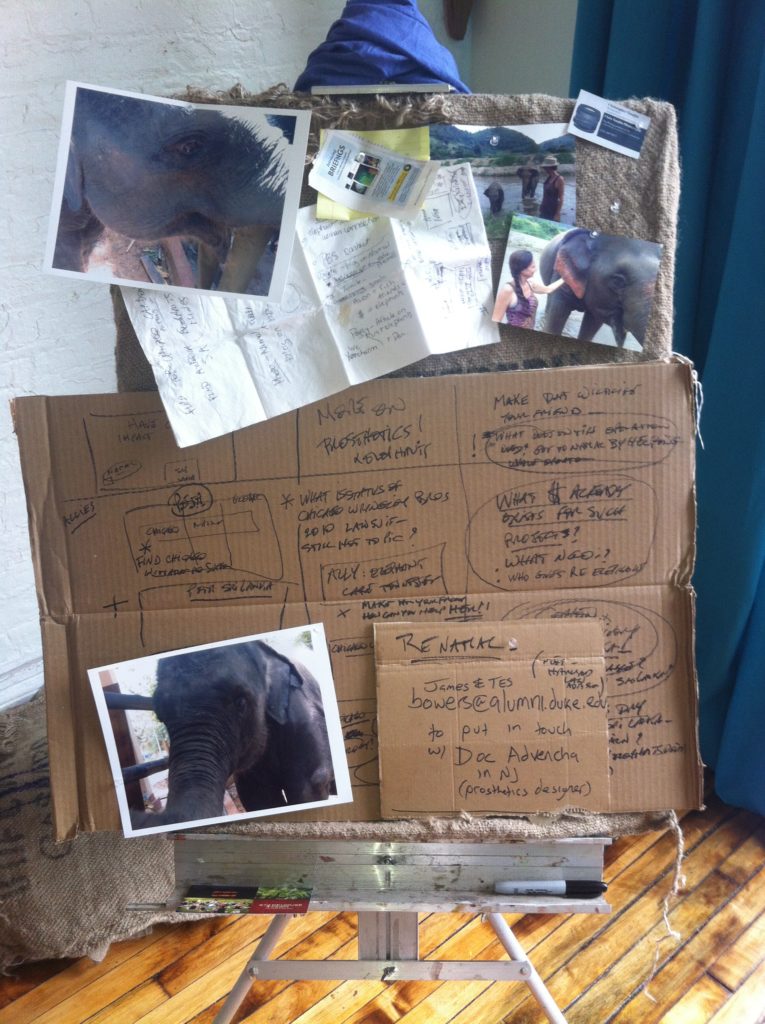
A “behind the scenes” look at our Namal fund raiser which started in our loft in Chicago in 2015.
Many of you have followed Namal’s story on Green Global Trek and Peta’s Facebook page and have inquired as to his well being. Thanks to many of you we were also able to successfully raise money to help Namal. These funds will be donated to the ETH which is now set up to receive contributions.
We hope to visit Namal again at the center, sometime soon.
What a remarkable story! Thank you for sharing it.
Thanks Peggy.
Our perspective is that the more exposure there is for the good work done by the Elephant Transit Home, the more likely they are to get donations which are crucial to their ability to help as many orphaned elephants as possible.
Peta
How wonderful! I hope Namal continues to thrive.
Thanks Anabel.
Namal has certainly had his challenges, but hopefully with this new leg, life will get a little bit easier for him. It is not easy for him to be kept separately from the others as he is unable to obviously keep up with the pace of normal elephants. And elephants are very social animals, so this has been another dimension of Namal’s challenge.
Peta
Thanks for the update on Namal and his prosthetic leg. I remember being extremely moved as well as heartened by reading your story of Namal and appreciate your efforts to educate your readers about the formidable challenges faced by Sri Lanka’s elephants.
Your blog is an eye-opener in so many ways and it’s been fascinating to learn more about your adopted country!
Thanks for following Namal’s story and progress, Anita. There are so many challenges for elephants in Sri Lanka and actually everywhere in the world. The upside is that Asian elephants do not have the large tusks that African elephants have and therefore are not targeted for their tusks. Another issue in Sri Lanka is the capturing of baby elephants to be kept as status symbols and as well, and more complicated, to be used in temple ceremonies and festivities, as has been done for centuries.
Thanks for the compliment about our blog, we appreciate the positive feedback.
Peta
How amazing and beneficial your journeys are. Thanks so much for expanding my world and touching my heart.
Thanks Eileen for stopping by to read us and to comment. I am so glad that this post was meaningful to you!
Peta
This is amazing!! Bless you for your part in making this happen. Please keep us up to date on Namal.
Thanks Darlene.
We played a small role in the overall success of this project and are so thankful to have met the team that is so passionate about Namal and helping him as he moves forward in life. It was serendipitous that a team of Sri Lankans were working on making this happen at the same time as we started our fundraiser in Chicago. We will definitely keep following Namal’s progress and hopefully get to visit some time soon and have new photos to post.
Peta
I remember the story of Namal and all the efforts you put in raising money and meeting with specialists …What a wonderful and successful achievement.
Thank you for keeping us aware of the situation there.
Merci Madame Bell.
What is most satisfying is that the ministry of wildlife has been able to organize a presence in social media, get coverage for the elephant transit home’s activities and that they have come up with multiple ways for people to help their cause. In short, they have become organized to be able to sustain the center over the life of elephants which means, the next hundred years.
Ben
It is heartwarming to hear of how he is progressing?
Thanks Gilda.
Peta
yay!
Zebras and elephants.
Ben
Namal is one lucky elephant, he is lucky to have you two taking care of him. Do you have a photo of his new leg? I couldn’t see one anywhere.
We take no credit for taking care of Namal. That job is a huge one to be sure and thankfully the Elephant Transit Home is there to provide for orphaned elephants. It is quite a sight to see all the babies coming to receive their milk feeding at the center. Next time we visit, I will be sure to capture this daily feeding ritual.
We are hoping to visit Namal soon and to be able to get a first hand photo of his new leg.
Ben
This story about Namal is so heartwarming, just what I needed to read this week. It’s wonderful to see people getting together and doing something wonderful for an elephant. Such amazing creatures they are, one of the many many many with whom we share this earth.
Shari, as animal lovers we could not agree more. I think that people often talk about helping and want to help, but it is great to see this team of Sri Lankans who took concrete action and made things happen.
Just last week, the local newspaper reported the story of the Wild Life Department workers who spent five hours helping to free three young elephants who had fallen into an unused water well.
Peta
This news is making me happy! It is comforting to know that good things still happen in this world… 🙂
Thanks Liesbet. Once you step out of the media barrage of all things negative 24/7, a more balanced perspective of good deeds and “shit happens” is restored.
Ben
Good job! So happy that you successfully organized a better life for Namal and other elephants. Kudos.
Thanks Dahlia however, we do not take any credit for improving Namal’s life. Of course that was our honored intention, but the way things worked out, a team got there before us. For which we are immensely grateful!
Peta
Hello, I found your blog through Sue Slaght’s and have been browsing some of your posts. We have a lot in common! My husband and I first went off vagabonding back in 2003. I warn you – it’s utterly addictive! I shall look forward to your next post. 🙂
Susan A Eames at
Travel, Fiction and Photos
Hi Susan and welcome to our Green Global Trek. Yes we are definitely confirmed travel addicts and have enjoyed many years of a nomadic lifestyle with consecutive living and looking forward to many more. No matter how many countries we travel to, the wish list seems to keep growing.
Wondering where your years of vagabond travels 🙂 have taken you both?
Peta
Wow how fabulous. What terrific passion for these animals. Good work guys, on bringing exposure to this great organisation. 🙂
Thank you Carol for your enthusiasm. Exposure in social media is critical to the ongoing success of the center.
Peta
Touching story, how you helped improve this beautiful creature’s life and mobility. Yay on both of you!
Thanks Amit. We did very little compared to the group on the ground. But we too are delighted that Namal has his prosthetic leg and is being well taken care of. The reality is that Namal will keep growing for the next fifteen years or so and therefore his prosthetic leg will need successive adjusting and realigning.
Peta
So heartwarming and inspiring! I wonder—did Namal ever get a dog as a companion? 🙂 I recall you saying that might be beneficial for him so that he won’t feel alone. I honor you both for your loving kindness and commitment to making this world a better place. Namaste.
Thanks Laurel. No Namal did not get a dog as a companion, or a sheep. It seems that our intentions were good yet there is a lot of red tape, rules and regulations and introducing a new animal as a companion was definitely “way out of the box.” I do believe that the way to “make the world a better place” is by helping one person or one animal at a time. Thanks for the encouragement and positive feedback.
Peta
Peta
So many heartwarming stories here. Your history and ongoing connection with Namal is incredible! My sister is an elephant activist (more in Africa), and she would love this story – will send it on!
Thanks Lex. Yup we are definitely the types that stick with a project as much as possible. We feel as though we are just at the beginning of our elephant relationships!
Would love to connect with your sister and hear about what she is doing and where in Africa? thanks for sending the post on to her…
Peta
Thank you for the update and your wonderful work. I’m so happy to hear about Namal’s new leg. I had no idea about the tragic train-elephant collision issue. How sad! I hope this will be addressed soon.
Thanks Caroline. There are many tragic issues here with elephants and sadly, the world over, with all of wildlife. One of the main problems it seems is that we humans keep destroying natural habitats by deforestation, planting of crops ~ in this case, doing it along the paths that elephants have used for food gathering for centuries.
Sadly I don’t think that any of these issues will be resolved. There are just too many interests associated with population growth and consumption everywhere that often conflict with wildlife preservation.
Peta & Ben
You might be interested to read about EHRA: Elephant Human Relations Aid — in Namibia. Different continent, but the need for desert elephants to access water–and the human/elephant conflicts that result–in a community of subsistence farmers led to the establishment of this awesome organization. I spent two weeks volunteering with them in 2014–one of the best things I’ve ever done.
Check it out–kindred spirits in Namibia. http://www.desertelephant.org/
You might be able to draw some ideas from their success.
Cheers!
Jane
Jane thank you so much for the link to EHRA. Seems like an incredible organization doing great work on the ground and having real impact. It could indeed be an inspiration and knowing how other countries have resolved elephant human conflicts is important and valuable information.
How great that you got to volunteer there for two weeks. Amazing.
Thanks for reading and commenting.
Peta & Ben
Very meaningful post! I ‘m thinking one of the solutions is keeping an eye on the elephants more? So that might mean more funding, esp. including the food problem? Or maybe barricades to stop the elephants on going over the tracks? People need to realize how animals can be such assets to environment, to people, and even so, as something to help with tourism. I could just hug those elephants.
Rommel thank you for your feedback.
The issue with finding a viable solution is that it must be one that does not require ongoing funding (for example, more people to watch the elephants). Also, the issue of “barricades” is unaffordable because elephants are notorious for blowing through the most robust of fences. So we need to think about the converse, which is not to redirect elephants, but rather, to provide train conductors with an early warning of elephants on the tracks. This is why we are thinking about how to obtain funding for infra red cameras that can be outfitted on trains that go along elephant routes and of course how to provide training to conductors so that they can interpret the data and bring their train to a halt to avoid direct impact.
Ben
I am passing this post along to so many people. Your story about Namal is incredible. I read as much as I can about elephants and other animals in the wild who are suffering due to human cruelty or just plain shared needs of food and water. You have tripled my knowledge of the problems and challenges ahead. Thanks to caring knowledgeable compassionate people like you two for taking the time to write and share your passion for the glorious elephant. ?
Thanks Pamela for sharing our post on Namal and for the encouragement!
One other issue which is not so prevalent in Sri Lanka, but in other Asian countries is that of tourists riding elephants. People do not understand that for a wild animal like an elephant, to be tamed, their spirit has to be broken first. It is a cruel and gruesome process, as you probably are aware, but the more we can spread the word about this issue, hopefully more tourists will come to realize this is not a practice that should be supported.
We will be revving up soon to take on one of the issues here locally and see what kind of impact we will have.. and it will be good to get the word out there for fundraising and awareness raising purposes, so thank you for sharing our posts on the topic of the wellbeing of elephants.
Ben & Peta
Oh my goodness gracious – I missed this incredible post while in a fibromyalgia-flare. I LOVE LOVE LOVE elephants – they have always been so special to me. It was gut-wrenching to me, even as a child, to see elephants isolated in zoos or paraded around for people to ride at amusement parks.
Peta, Ben, I’m so glad you were in the right place at the right time to help!
Judy
Does “Namal” have a meaning or just a “name”?
Love your enthusiasm Judy… I feel the same way about elephants and as well as a child was saddened by seeing them in a zoo after having seen them in the wild at Kruger National Park. I immediately thought that animals in zoos were in jail and I still do. (Of course some zoos are better than others in creating natural habitat)
As far as we know there is no specific meaning for the name Namal. But maybe it just means “fuzzy giant” ha ha 🙂
Peta